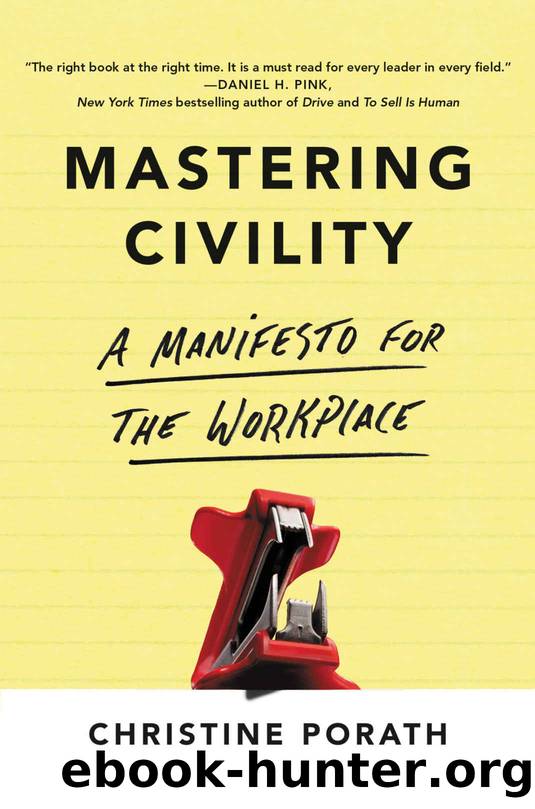Mastering Civility: A Manifesto for the Workplace by Christine Porath

Author:Christine Porath [Porath, Christine]
Language: eng
Format: epub
Tags: Biography + Memoir
ISBN: 9781455568987
Google: Sv43DAAAQBAJ
Amazon: 1455568988
Published: 2016-12-27T06:00:00+00:00
Set a Tone of Respect
Leaders establish norms about respectful e-mail conduct through their own habits and routines. For instance, if leaders typically send out e-mails in the evenings and during the weekends, employees will likely feel compelled to read and respond to them. Even if leaders donât expect responses, their actions tell a different story.
If you write e-mails at all hours, consider placing them in draft folders until working hours or use a delayed delivery service. Youâll get a faster reply. According to research based on more than two million e-mail users, people respond to e-mail faster during working hours. 7 Delayed delivery can also be used when you know someone is out of his or her office, on vacation, or in a different time zone. If youâre sending e-mails during the workday, donât expect your employees to respond immediately. If you do, youâll find that your employees are distracted, stressed out, and less productive, responding to a deluge of incoming e-mails rather than tackling higher priority items.
When Gloria Mark at the University of California, Irvine, took away e-mail for five days from a group of US Army civilian employees, she found that stress levels, measured by heart monitors, decreased. People reported feeling more in control of their working lives, and they tended to engage in more face-to-face conversations. They also reported being far more productive. 8
Mark recommends that organizations and leaders encourage employees to read e-mails at limited times during the day versus continually checking for them. 9 Other research has borne out the merits of this approach. In a two-week experiment, researchers asked adults to check their inbox three times a day for a week and another group of adults to check as often as they wanted. The next week, they reversed the instructions for the groups. Employees who checked their e-mail only three times a day reported being far less stressed after one week than employees told to check e-mail freely. The âe-mail-minimalizersâ answered roughly as many e-mails as those who checked e-mail often, but in 20 percent less time. 10
Download
This site does not store any files on its server. We only index and link to content provided by other sites. Please contact the content providers to delete copyright contents if any and email us, we'll remove relevant links or contents immediately.
Harry Potter and the Goblet Of Fire by J.K. Rowling(3077)
Never by Ken Follett(2907)
Shadow of Night by Deborah Harkness(2731)
Ogilvy on Advertising by David Ogilvy(2692)
Zero to IPO: Over $1 Trillion of Actionable Advice from the World's Most Successful Entrepreneurs by Frederic Kerrest(2436)
Machine Learning at Scale with H2O by Gregory Keys | David Whiting(2316)
The Man Who Died Twice by Richard Osman(2307)
Book of Life by Deborah Harkness(2274)
How Proust Can Change Your Life by Alain De Botton(2266)
My Brilliant Friend by Elena Ferrante(2232)
0041152001443424520 .pdf by Unknown(2228)
The Tipping Point by Malcolm Gladwell(2207)
How to Pay Zero Taxes, 2018 by Jeff A. Schnepper(2106)
Will by Will Smith(2061)
Hooked: A Dark, Contemporary Romance (Never After Series) by Emily McIntire(1994)
Purple Hibiscus by Chimamanda Ngozi Adichie(1992)
Borders by unknow(1791)
Rationality by Steven Pinker(1773)
Daughter of Smoke and Bone by Laini Taylor(1750)
